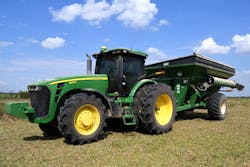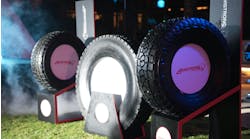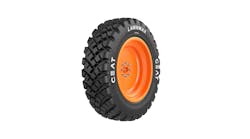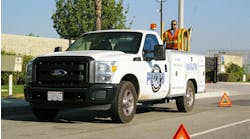Modern Tire Dealer has partnered with AG Tire Talk to provide answers to insightful questions that farm tire dealers have about farm tire technology. This is the next installment in our ongoing series, which is designed to help farm tire dealers better connect with their customers. A trending question, followed by answers, will appear in our Commercial Tire Dealer section every other month. For complete answers, click on www.agtiretalk.com.
QUESTION: Why are farmers hesitant to run ag tires at recommended single-digit psi levels? What is required to do so? What precautions must be taken and how are traction and flotation improved?
Dave Paulk, manager, field technical services, BKT USA Inc.: Today’s ag radials are made to run at higher deflections and lower air pressures. Lower air pressures reduce ground bearing pressure and soil compaction.
With lower air pressures, the tire has a wider and a longer footprint to spread out the weight of the tractor over a larger contact area. The ability to run lower air pressures in the field is a definite advantage to taking care of the ground and increasing traction and flotation. The wider and flatter the footprint of the tire, the better the traction and stability. There are also perils to running low inflation pressures in the field and once out of the field.
Modern tire construction has been improved to allow low pressures with the production of increased flexion (IF) and very high-flexion (VF) technology. An IF-rated tire can carry 20% more weight at the same air pressure as a standard tire or conversely can run about 20% less air pressure and carry the same weight as a standard tire. A VF-rated tire can carry 40% more weight at the same air pressure as a standard tire, and the same weight as a standard at about 40% less air pressure.
A tire must have the correct amount of air pressure to carry the weight of the tractor and implement. It is always best to prepare for the worst-case scenario. A tractor tire running at single-digit air pressures at a field speed of five to 10 mph may be able to carry that weight, but as speed increases, the weight carrying capacity of a tire decreases. Nine psi in the field at five to 10 mph does not equal nine psi on the road at 30 mph. Once out of the field and on the road, air pressures must be increased to handle the weight at road speed. On the road, higher air pressures are needed for higher speeds and lower rolling resistance for fuel savings. In the field, lower air pressures can be used for lower speeds and wider footprints for more traction and less compaction. Air pressures that are too low will cause an overload condition and destroy the sidewalls of the tire.
The size of the implements and the application can also determine how much air pressure should be used. Lower air pressures can generally be used in the field when the implement is hooked to the drawbar. The full weight of the implement (seeder, cultivator, etc.) is not on the tractor.
In some areas, 16-row planters are used on the three-point hitch. While the planters are on the ground, air pressures can be low. When the planters are picked up at the end of the row, all the weight is on the back of the tractor and air pressures need to be higher. This is an example where the worst-case scenario option needs to be used. Air pressures should be set to handle the planter when they are in the air. Duals work best in situations where there is a lot of weight on the rear of the tractor due to heavy drawbar weight or use of the three-point hitch. With duals, air pressure can be further reduced than if singles are used. Duals may also be needed to carry the heavy weight.
Farming on hillsides and slopes requires higher air pressures, even though they may not be needed to carry the weight of the tractor and implement. Running lower air pressures on hillsides can buckle the sidewall of the tires because weight shifts from one side to the other. Hillsides and slopes are not the application to run single-digit air pressures.
Austin Fischer, ag field engineer, Firestone Ag:-I think there are two key reasons producers are hesitant to run ag tires at single digit psi levels. First, single-digit psi levels require growers to be more diligent about checking pressures, given the reduced margin for error. For example, if a farmer runs six psi and loses one psi, that equates to a loss of 17% of the inflation pressure. But if they run 35 psi and lose one, the percentage lost is much smaller at only 3%.
The second reason some producers may be hesitant to run ag tires at single-digit psi levels is that it becomes even more critical that they know the actual maximum axle loads that the tires will be subjected to. As discussed above, the margin for error is reduced significantly at single-digit inflation pressures, so one needs to be sure the tire can handle the load(s) it will see in service at that low of an inflation pressure. Growers must consequently be really dialed in on how much their base machines weigh, as well as the weight added by implements, weight packages, aftermarket attachments, etc.
To run farm tires at recommended single-digit PSIs, growers must know their maximum axle loads and the inflation pressures that their tires require to carry those loads. It’s also critical to diligently monitor tire pressure when running ag tires on single-digit psi levels, as they can’t just be set and left alone.
Firestone Ag recommends checking tires at least once per day, perhaps in the morning while allowing the machine to warm up. We also suggest using an accurate, high-quality air pressure gauge that has been calibrated and is no more than 15 years old. Other tools that can help growers include a tire pressure monitoring system, which automatically alerts operators when pressure drops below recommended levels, and a central tire inflation system to help keep tires in the appropriate pressure range.
Finally, dealers need to make sure their customers’ tires and wheels are in good shape. If tires are weather-checked or worn down to 20% or less, they should be replaced. If wheels are rusty or damaged, consider replacing them before trying to run tires on single digit psi levels.
It is imperative for producers to know their maximum axle loads and to be familiar with their tires’ load-inflation tables. They must have a firm grasp of both these details before they can pursue single-digit inflation pressures. Additionally, growers must be committed to diligently checking the inflation pressures and overall conditions of the tires at least every day. If they are not sure whether this is something they will be able to do, then it may be best to run a few extra psi over the minimum amount required to carry the load.
Another precaution is to be cognizant of the terrain on which the tires will be operating. If the tires will be operating in very hilly terrain, then we would recommend running four to six psi over the minimum pressure required to carry the load to increase lateral stability. This is especially important if the tires in question are IF- or VF-designated, due to the increased deflection inherent with those designs of tires. Lastly, we recommend that dealers ensure their customers’ tires are fully seated on the wheels. This can be done by visually confirming that the tire beads are fully against the vertical portion of the wheel flange and concentric with the wheel. If a tire is not fully seated on the wheel, its beads could potentially unseat during operation.
Greg Gilland, vice president, global agriculture, Maxam Tire North America Inc.: Agricultural tires — in comparison to construction, commercial truck, and passenger or light truck tires — operate best at the lowest air pressure possible. The primary reason agricultural tires can operate at such low pressures is the combination of the size of the air chamber in an ag tire and the number of tires mounted on a vehicle, allowing lower air pressures to be able to carry the weight.
The secondary reason ag tires need to operate at the lowest air pressure possible is to reduce the effect of the machine weight on the soil by decreasing the ground pressure and soil compaction. Agricultural tires operating at the best possible pressure have a direct impact on crop production and can improve farmers’ and growers’ yields.
On average, agricultural tires tend to operate between 12-20 psi on tractors working in the field. The advent of IF and VF technology is allowing tire air pressures to achieve much lower pressure, down to nine psi. The structural capability of tires impacts how much air pressure is required to carry the intended axle load. Radial tire casing construction carries 20% of the axle load, while the pressurized air in the chamber carries the remaining 80%. Bias tire casing construction carries 40% of the axle load, while the pressurized air in the chamber carries the remaining 60%
As technology continues to evolve with radial tires, especially with VF tires, the ability to operate continuously at a working air pressure of nine psi has become a commercial reality. Fundamentally, VF Technology allows farmers to significantly lower air pressure without compromising the carrying capacity of the tire. This results in a much longer tire footprint or gross flat plate that spreads the weight of axle over a larger area, which significantly reduces the ground pressure effect and lowers soil compaction improving the producer’s crop yield.
Advantages of VF tire solutions that can operate at low air inflation pressures include sturdier tire construction that is designed to be very flexible, without compromising casing endurance or tire life; greater load carrying capacity, by adjusting air pressure as needed; reduced soil compaction and improved crop yields due to the larger footprint and increased flotation; higher heat resistance; a long footprint for increased contact patch, traction and reduced slip; improved ride; and more.
With all the above technological reasons that should convince or drive producers to convert to IF or VF tires, here are the primary reasons producers hesitate to operate at these pressures: the perception that the tires operating at low pressure are too low or look flat; concern when having to transport (road) the machinery that lower air pressures will slow the equipment or consume more fuel; the perception that low air pressure could lead to a tire flat in a remote area; historically perceived comfort for operating at 16-18 psi as the lowest threshold of air inflation in the field; concern that they must continuously adjust air pressures up or down, which is time-consuming when changing equipment based on expected axle loads; and discomfort with operating at one set inflation pressure that addresses all their equipment or load variables.
David Graden, operational market manager, agriculture, Michelin North America Inc.: In my experience, almost nine times out of 10, producers are very reluctant to reduce their ag tire pressures to recommended single-digit, operational pressures. In most cases, I believe this is due to their historic experience running higher pressures, or even the maximum pressure stamped on the sidewall of the tire.
When we recommend single digit pressures to producers, we always have to begin with the “why” behind our recommendation. I could easily spend an hour on this topic. However, the key points are improved traction due to a larger footprint and more lugs on the ground, which significantly improves floatation, then reduced soil compaction, better crop yield and improved fuel economy; and finally, an overall improvement in efficiency and added money to the customer’s bottom line.
Unfortunately, it isn’t as easy as simply reducing your tire pressure until you see three lugs on the ground, either. How do we reach that single digit recommendation? Well, to begin, the producer’s tires must fit the application. Is the machine strictly confined to field use? Does it travel over the road and how much? Are the tires under significant torque? Is the machine’s weight properly distributed to transfer the necessary torque for the application?
Chris Neidert, marketing, training and development manager, ag, Trelleborg Wheel Systems: Let’s go over some basic instructions when trying to determine air pressure. The tractor must be first ballasted correctly, meaning the total weight of the tractor necessary to transfer the tractor engine output torque with high efficiency to the ground. The weight distribution must then be determined, meaning how much weight should be over the front axle and how much weight should be over the rear axle.
When the above conditions have been met, dealers can then consult the tire manufacturer’s load table. Find the load table for that particular tire size. If you’re using tire brand A, you must use the load table from tire manufacturer A to determine the air pressure. It is not recommended to use a load table from a different tire manufacturer as nominal conditions and load capacities could vary between manufacturers.
Blaine Cox, national product manager – agriculture, golf and turf, Yokohama Off-Highway Tires America Inc.: Remember that manufacturers design every aspect of a tire to perform within the bounds you see on the load and inflation table — how much movement famers will experience in the sidewalls, how the bead performs, how much heat will be generated by the movement of the tire and the shape of the footprint, among other factors.
Below-spec inflation pressure can create excess heat, apply stress to parts of the sidewall and under-tread that it is not built to handle and cause other problems. Tires also rely on inflation pressure to maintain the bead’s lock on the wheel. Too little pressure could allow the tire to fall off the wheel, especially if it is being operated on a sidehill. Load carrying capacity and top speed should always be within the bounds of the load and inflation table, noting special applications like steep slope air pressure increase adjustments.




